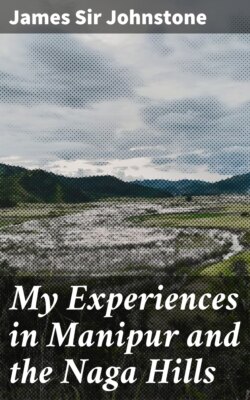Читать книгу My Experiences in Manipur and the Naga Hills - Sir James Johnstone - Страница 7
На сайте Литреса книга снята с продажи.
Chapter III.
ОглавлениеTable of Contents
Historical events connected with Manipur and the Naga Hills—Different tribes—Their religion—Food and customs.
Shortly after my arrival at Samagudting, I received a cheering letter, just when I most needed it, from my old friend Wynne, then Acting Foreign Secretary, saying, “Don’t be too disappointed at not receiving a better appointment than the Naga Hills. You will have plenty of good work to do, and you will increase your already very extensive knowledge of wild tribes.” It was the last letter I ever received from him, as cholera quickly carried him off, and I lost in him one of the kindest friends I ever had, one who had constantly interested himself in my work, and given me advice. Such a friend would have been invaluable now. Our position in the Naga Hills was an anxious one, and can only be properly realised by knowing the course of previous events.
Our first acquaintance with the Nagas practically began in 1832, when Captain Jenkins and Lieutenant Pemberton escorted by Rajah Ghumbeer Singh’s Manipur troops, forced a passage through the hills with a view to ascertaining if there were a practicable route into Assam. They came viâ Paptongmai and Samagudting to Mohong Deejood. There is every reason to believe that the Manipuris in former days did penetrate into the Naga Hills, and exacted tribute when they felt strong enough to do so. All the villages have Manipur names in addition to their own. But during the period of her decadence, just before and during the Burmese War of 1819–25, any influence Manipur may have possessed fell into abeyance. At that time it was re-asserted, and Ghumbeer Singh reduced several villages to submission, including the largest of all, Kohima, at which place he stood upon a stone and had his footprints sculptured on it, in token of conquest. This was set up in a prominent position, together with an upright stone bearing carved figures and an inscription.
The Nagas greatly respected this stone and cleaned it from time to time. They opened a large trade with Manipur, and whenever a Manipuri visited a Naga village he was treated as an honoured guest, at a time when a British subject could not venture into the interior without risk of being murdered.
Kohima Stone.
[Page 23.
Even up to the Naga Hills campaign of 1879–80, the Nagas regarded Manipur as the greater power of the two, because her conduct was consistent; if she threatened, she acted. One British subject after another might be murdered with impunity, but woe betide the village that murdered a subject of Manipur. A force of Manipuris was instantly despatched, the village was attacked, destroyed, and ample compensation exacted. The system answered well for Manipur; many of the Nagas began to speak Manipuri, and several villages paid an annual tribute. Still, up to 1851, we considered that we had some shadowy claim to the hills, though we never openly asserted it.
I may as well give a short account of the different tribes inhabiting the Naga Hills district when I took charge. The oldest were—
